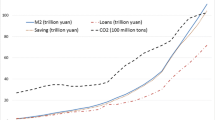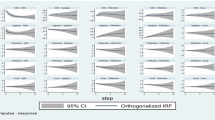Abstract
Climate change is a challenge for all of humanity. Should financial be environmentally responsible? This paper uses the Toda–Yamamoto test and the extended Fourier Toda–Yamamoto test re-examine the relationship between financial development and environmental quality in 31 provinces and municipalities in China during the period 2000–2018. We find that financial development in certain regions has effectively reduced the concentration of PM2.5, which indicates that it has a significantly positive effect on environmental quality, though with regional differences. After considering structural shifts, the relationship between financial development and environmental improvement is found to be significant in more regions, indicating that China has undergone structural shifts in these aspects. The aforementioned conclusions are also supported by further robustness tests. China can consequently utilize the positive impact of finance for advocating carbon emission reduction and improving environment quality, therefore contributing to the response to global climate change.



Similar content being viewed by others
Data availability
The data can be available upon request.
Notes
The data for 2019 and 2020 are affected by the epidemic; hence, the analysis sample only includes data before 2018.
By setting different fitting parameters, the goodness of fit of the fitting curve to the index reaches over 0.5.
References
Balcilar M, Ozdemir ZA, Arslanturk Y (2010) Economic growth and energy consumption causal nexus viewed through a bootstrap rolling window. Energ Econ 32:1398–1410
Balsalobre-Lorente D, Ibáñez-Luzón L, Usman M, Shahbaz M (2022) The environmental Kuznets curve, based on the economic complexity, and the pollution haven hypothesis in PIIGS countries. Renew Energ 185:1441–1455
Becker R, Enders W, Hurn S (2004) A general test for time dependence in parameters. J Appl Economet 19:899–906
Becker R, Enders W, Lee J (2006) A stationarity test in the presence of an unknown number of smooth breaks. J Time Ser Anal 27:381–409
Bekhet HA, Matar A, Yasmin T (2017) CO2 emissions, energy consumption, economic growth, and financial development in GCC countries: dynamic simultaneous equation models. Renew Sust Energ Rev 70:117–132
Brännlund R, Ghalwash T, Nordström J (2007) Increased energy efficiency and the rebound effect: effects on consumption and emissions. Energ Econ 29:1–17
Claessens S, Feijen E (2007) Financial sector development and the millennium development goals. World Bank Publications, Washington, D.C.
Cole MA, Elliott RJ, Shimamoto K (2005) Industrial characteristics, environmental regulations and air pollution: an analysis of the UK manufacturing sector. J Environ Econ Manag 50:121–143
Doğan B, Chu LK, Ghosh S, Dieptruong HH, Balsalobre-Lorente D (2022) How are environmental tax and carbon emissions are related in the G7 economies? Renew Energ 187:645–656
Dolado JJ, Lütkepohl H (1996) Making Wald tests work for co-integrated VAR systems. Economet Rev 15:369–386
Dong Q, Wen S, Liu X (2020) Credit allocation, pollution, and sustainable growth: theory and evidence from China. Emerg Mark Financ Tr 56:2793–2811
Efron B (1979) Bootstrap methods: another look at the jackknife. Ann Stat 7:1–26
Enders W, Jones P (2016) Grain prices, oil prices, and multiple smooth breaks in a VAR. Stud Nonlinear Dyn E 20:399–419
Enders W, Lee J (2012) The flexible fourier form and Dickey-Fuller type unit root tests. Econ Lett 117(1):196–199
Fuller DWA (1979) Distribution of the estimators for autoregressive time series with a unit root. J Am Stat Assoc 79(366):355–367
Granger CW (1969) Investigating causal relations by econometric models: cross-spectral methods. J Econ Soc 37(3):424–438
Hacker RS, Hatemi-J A (2006) Tests for causality between integrated variables using asymptotic and bootstrap distributions: theory and application. Appl Econ 38:1489–1500
Hammer MS, van Donkelaar A, Li C, Lyapustin A, Sayer AM, Hsu NC, Levy RC, Garay MJ, Kalashnikova OV, Kahn RA (2020) Global estimates and long-term trends of fine particulate matter concentrations(1998–2018). Environ Sci Technol 54:7879–7890
Hatemi-J A (2002) Export performance and economic growth nexus in Japan: a bootstrap approach. Jpn World Econ 14:25–33
Jahanger A, Usman M, Murshed M, Mahmood H, Balsalobre-Lorenteef D (2022) The linkages between natural resources, human capital, globalization, economic growth, financial development, and ecological footprint: the moderating role of technological innovations. Resour Policy 76:102569
Jalil A, Feridun M (2011) The impact of growth, energy and financial development on the environment in China: a co-integration analysis. Energ Econ 33:284–291
Jiang T, Yu Y, Jahanger A, Balsalobre-Lorente D (2022) Structural emissions reduction of China’s power and heating industry under the goal of “double carbon”: a perspective from input-output analysis. Sustain Prod Consump 31:346–356
Kónya L (2006) Exports and growth: granger causality analysis on OECD countries with a panel data approach. Econ Model 23(6):978–992
Kumbaroğlu G, Karali N, Arıkan Y (2008) CO2, GDP and RET: an aggregate economic equilibrium analysis for Turkey. Energ Policy 36:2694–2708
Liu X, Wen Y (2019) Should China’s financial institutions assume environmental responsibility? Econ Res J 54:40–56
Mantalos P (2000) A graphical investigation of the size and power of the Granger-causality tests in integrated-cointegrated VAR systems. Stud Nonlinear Dyn E 4:1053
Nazlioglu S, Gormus NA, Soytas U (2016) Oil prices and real estate investment trusts (REITs): gradual-shift causality and volatility transmission analysis. Energ Econ 60:168–175
Omri A, Daly S, Rault C, Chaibi A (2015) Financial development, environmental quality, trade and economic growth: what causes what in MENA countries. Energ Econ 48:242–252
Ozturk I, Acaravci A (2013) The long-run and causal analysis of energy, growth, openness and financial development on carbon emissions in Turkey. Energ Econ 36:262–267
Sadorsky P (2010) The impact of financial development on energy consumption in emerging economies. Energ Policy 38:2528–2535
Shahbaz M, Hye QMA, Tiwari AK, Leitão NC (2013) Economic growth, energy consumption, financial development, international trade and CO2 emissions in Indonesia. Renew Sust Energ Rev 25:109–121
Shahbaz M, Solarin SA, Mahmood H, Arouri M (2013) Does financial development reduce CO2 emissions in Malaysian economy? A Time Series Analysis. Econ Model 35:145–152
Shahzad SJH, Kumar RR, Zakaria M, Hurr M (2017) Carbon emission, energy consumption, trade openness and financial development in Pakistan: a revisit. Renew Sust Energ Rev 70:185–192
Tamazian A, Rao BB (2010) Do economic, financial and institutional developments matter for environmental degradation? Evidence from Transitional Economies. Energ Econ 32:137–145
Tamazian A, Chousa JP, Vadlamannati KC (2009) Does higher economic and financial development lead to environmental degradation: evidence from BRIC countries. Energ Policy 37:246–253
Toda HY, Yamamoto T (1995) Statistical inference in vector auto-regressions with possibly integrated processes. J Econ 66:225–250
Usman M, Balsalobre-Lorente D (2022) Environmental concern in the era of industrialization: can financial development, renewable energy and natural resources alleviate some load? Energ Policy 162:112780
Van Donkelaar A, Martin RV, Li C, Burnett RT (2019) Regional estimates of chemical composition of fine particulate matter using a combined geoscience-statistical method with information from satellites, models, and monitors. Environ Sci Technol. 53:2595–2611
Ventosa-Santaulària D, Vera-Valdés JE (2008) Granger-causality in the presence of structural breaks. Econ B 3:1–14
Wen S, Liu X (2019) Financial mismatch, environmental pollution and sustainable growth. Econ Manag Res 40:3–20
Yan C, Li T, Lan W (2016) Financial development, innovation and carbon emission. Financ Res 427:14–30
Yu X, Chen Z (2011) Resource abundance and financial development: evidence from China. Resour Policy 36:72–79
Zhang YJ (2011) The impact of financial development on carbon emissions: an empirical analysis in China. Energ Policy 39:2197–2203
Zivot E, Andrews DWK (1992) Further evidence on the great crash, the oil-price shock, and the unit-root hypothesis. J Bus Econ Stat 20(1):25–44
Funding
This work was supported by Youth Foundation of Social Science and Humanity, China Ministry of Education (20YJC790133).
Author information
Authors and Affiliations
Contributions
All authors contributed to the study conception and design. Material preparation, data collection, and analysis were performed by Yiguo Chen, Peng Luo, Teng Tong, and Jing Wang. The first draft of the manuscript was written by Yiguo Chen and all authors commented on previous versions of the manuscript. Tsangyao Chang revised it critically for important intellectual content. All authors read and approved the final manuscript.
Corresponding author
Ethics declarations
Ethics approval and consent to participate
We declare that we have no human participants, human data, or human tissues.
Consent for publication
N/A.
Competing interests
The authors declare no competing interests.
Additional information
Responsible Editor: Arshian Sharif
Publisher's note
Springer Nature remains neutral with regard to jurisdictional claims in published maps and institutional affiliations.
Rights and permissions
About this article
Cite this article
Chen, Y., Luo, P., Tong, T. et al. Revisit causal nexus between financial development and environmental quality in China: a structural shift panel data analysis. Environ Sci Pollut Res 29, 89969–89985 (2022). https://doi.org/10.1007/s11356-022-21684-y
Received:
Accepted:
Published:
Issue Date:
DOI: https://doi.org/10.1007/s11356-022-21684-y




